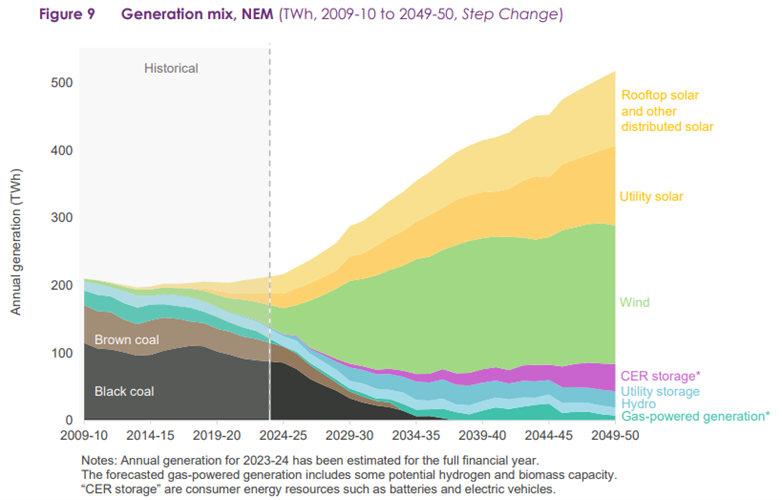Investing in lithium is hard
For investors looking for exposure to the global decarbonisation opportunity, there have been few more volatile experiences than investing in the mining of battery minerals. Lithium, graphite and the rare earth investments have been the cause of many sleepless nights.
While the reasons for softer commodity prices are many, the key issue has been a slower-than-expected uptake for electric vehicles (EVs). Consumers are choosing to defer EV purchases or pivot to hybrid vehicles in response to a lack of network infrastructure needed to support an EV fleet.
So, if demand for EVs is dependent on the buildout of infrastructure, a lower risk investment in the decarbonisation thematic might be via exposure to the infrastructure build itself. Household and business energy consumption from the grid is forecast to nearly double by 2050. Due to the retirement of coal generation, this will require a seven-fold increase in renewable generation and approximately 10,000km of new transmission lines to connect that power to customers. The image below shows the sheer scale of change required to the National Energy Market (NEM). Importantly for investors, if private industry investment in infrastructure does lose momentum, the government is almost certain to step in and push the infrastructure build through as part of its public commitments.

In this Wire we explore three ASX Small Caps that are participating in the buildout of infrastructure to support the EV transition. These are real businesses, with growing cashflows. A different investment proposition to early-stage battery mineral mining companies.
MAAS Group (MGH.ASX)
What is the company and how do they make money?
Maas is a civil construction and building materials business with operations in key Australin growth corridors including reginal NSW, QLD and suburban Melbourne.
How does the company participate in the electrification of Australia?
In January the Australian Energy Market Operator (AEMO) issued a 20-year roadmap for energy transition. The plan includes 43 ‘Renewable Energy Zones’ (REZs), which are strategic locations identified as key sources of renewable energy creation under the generation plan. In most cases these are wind and solar farms. MGH’s core civil and quarry assets are located nearby three of Australis largest REZ’s in the Central-West, New England and Darling Downs. Due to the company’s scale and capability in these local areas we expect it to see heightened demand for its services and assets as these energy zones are constructed.
Investment case
The regional investment in renewable generation is in the first year of a 20-year investment cycle. MGH’s scarce resources, particularly its local quarry assets are likely to enjoy strong pricing power and ROIC. The stock is 49% owned by founder Wes Maas and trades on an undemanding PE ratio of 13x FY25.
GenusPlus Group (GNP.ASX)
What is the company and how do they make money?
GenusPlus is a WA based power service provider specialising in renewable power, battery energy storage and transmission infrastructure. The company has more recently moved its focus to the much larger East Coast network and renewable opportunities.
How does the company participate in the electrification of Australia?
The key opportunity for GNP is participating in the large investment required in the transmission network outlined by the AEMO. New transmission capability is needed to connect the new generation and storage capacity to towns, cities and industry across the energy market. As mentioned above, close to 10,000 km of transmission lines are needed by 2050. In addition, GNP has been prominent in the award of major storage (battery) contracts including a recent 500MW contract with Samsung.
Investment case
The need for improved transmission capability of the network is considered urgent by the AEMO, and is receiving preferential funding allocations. We have already seen GNP participate in early large-scale projects.
GNP’s competitive advantage is the technical ability of its workforce. Not surprisingly the AEMO has called out workforce shortages globally as a key issue for its projects. As an acceleration of new projects absorb industry capacity is coming years, GNP should generate out-sized margins. The stock is 53% owned by founder David Riches and trades on an undemanding PE ratio of 14x FY25.
Beach Energy (BPT.ASX)
What is the company and how do they make money?
Beach Energy is an oil and gas exploration and development company and is a key supplier of gas into the Australian East and West coast gas markets.
How does the company participate in the electrification of Australia?
While Beach Energy might be a surprise inclusion to a list of electrification benefactors, gas has been identified as a key enabler for the economy’s transition to net zero. The AEMO roadmap expects electricity from gas-powered generation ‘to continue providing back-up supply during long periods of renewable droughts’. While hydro generation is consistent, solar and wind are variable resources, so different forms of storage and firming, like gas, are needed across the energy market to smooth out the peaks and troughs in renewable generation. At BPT’s Strategy update last week the company stated a desire to invest in downstream storage and peaking energy generation.
Investment case
Only 7 days ago the AEMO convened an emergency meeting with the gas industry, highlighting that gas supplies may be insufficient to meet demand this winter season. As a result spot prices for gas have spiked to double the usual rate. The addition of more gas-powered generation in future will only add to already constrained supply.
Given the long lead-times for renewable generation we are likely to see sustained higher energy prices in the meantime. We expect domestic gas producers to benefit from periods of above-average peak pricing as coal generation is wound back over the next decade. Longer-term, gas is likely to remain a strategic asset as part of the future energy solution.
BPT’s valuation is cheap, with its cashflow yield increasing to ~25% in 2 years. Incoming CEO Brett Woods (ex Santos) has recently reset expectations for the company and outlined a plan to streamline the cost base. Going forward BPT should be more leveraged to the improving supply/demand dynamics for domestic gas. This reset event has created a good entry point for investors.
Overall, Australia and most other countries are only in the very early stages of rebuilding their energy markets. This is an enormous task and will be led by government, rather than the private sector, which can be impacted by short-term economics. While the share prices of some of the companies listed above have traded strongly recently, the scale and sustainability of demand is likely to surprise to the upside.
5 topics
3 stocks mentioned
.jpg)
.jpg)